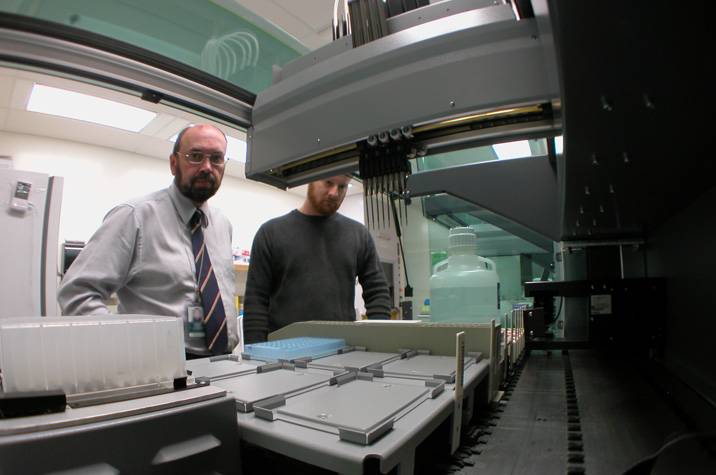Transformative technology: how the emerging science of DNA provided answers
By Derek Johnston

DNA robots were first used by the RCMP when the National DNA Data Bank opened in June 2000, and enabled the large-scale rapid processing of DNA samples.
Image by Ron Fourney
June 3, 2024
Content
Trigger warning: sexual assault, death
Two landmark events, less than a decade apart, would prove beyond any doubt the revolutionary impact of forensic DNA analysis, and Doctor Ron Fourney, an RCMP scientist, had a key role to play in both of them.
Deoxyribonucleic acid, or DNA, can be thought of as the body's chemical blueprint. With the exception of identical twins, each person carries their own unique DNA profile, passed down from parents to children. The first forensic applications of DNA typing were in immigration and paternity cases to prove biological relationships.
Landmark criminal case
In Canada, a major DNA-typing breakthrough in a criminal trial was connected to a brutal sexual assault case in 1988 involving a 68-year-old widow. The accused was Paul Joseph McNally, a 32-year-old, married father of two who repeatedly denied any involvement in the crime. The case represented the first time that DNA evidence developed by a Canadian forensic laboratory led to a criminal conviction.
“When I joined the organization in 1988, I was part of a small DNA team with Doctor Gary Shutler and Doctor John Waye,” recalls Fourney, who teamed up with Waye to conduct the sample analysis in the McNally case. “We did the tests and it was a match! We repeated the procedures three or four more times just to make sure.”
Waye and Fourney were hired to apply DNA typing to a forensic setting. Until that time, the preferred method had been serology, Doctor Shutler's area of expertise, which could be used to find evidence that associated an individual to an identifiable body fluid, such as blood, semen, saliva, or sweat.
“The best result you could hope for with a serology test was to narrow down the potential suspect pool to around 10% of a known population,” explains Fourney. “DNA analysis gave us the ability to match a biological sample to a single individual.”
Irrefutable evidence
When the results of the analysis in the McNally case were presented in court, Fourney says everyone was stunned. They revealed that the odds of someone other than McNally having the same DNA profile in the Canadian population was one in 74 billion.
The suspect's lawyer had lined up a genetics expert to cast doubt on the DNA findings, but the quality control and procedural standards in the RCMP lab were beyond reproach. The expert was never called. McNally abruptly changed his plea to guilty and was sentenced to seven years in prison.
“This case drove home the point that we now had a technology that was the ultimate in human identification,” adds Fourney.
DNA typing has revolutionized the criminal justice system. The technology has had dramatic effect in other applications, such as identifying victims of natural or largescale disasters.
Swissair Flight 111
The 1998 crash of Swissair Flight 111 near Peggy's Cove, Nova Scotia, demonstrated that DNA analysis could identify human remains, even under the most challenging circumstances. At the time, it was the largest DNA identification project in Canadian history — and Doctor Ron Fourney led the effort.
“We felt like we had an important role to play in supporting the victims' families,” he remembers.
The task was daunting. The aircraft broke apart on impact with the water, scattering debris over several kilometres. The massive recovery operation collected 15,000 body parts, many of which were a challenge to analyze.
Painstaking identification
Police from 12 countries searched victims' homes for latent fingerprints and personal items that might have contained DNA. RCMP staff, with support from other labs across the country, spent countless hours analyzing more than 1,300 samples from the crash and looking for matches with the personal items collected and family reference samples.
In the end, DNA analysis was used to validate dental records, fingerprints, and x-rays to identify all of the victims. The operation was completed in just over 100 days.
“It was a monumental undertaking, and it took a real toll on everybody involved,” admits Fourney. “Fundamentally, we were motivated by a humanitarian desire to help the families by identifying their loved ones at a time of unspeakable tragedy. In life, our greatest personal dignity is our identification. We owe this to each unidentified and missing person.”
For Fourney, who recently retired, DNA analysis has more than lived up to the lofty expectations that followed those early criminal convictions and the Swissair recovery mission. “There's a lot more ahead of us than behind us,” he says.